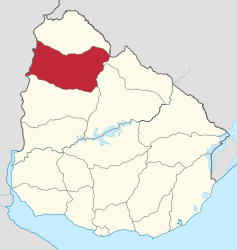Salto Department
| Somersault | |||
|---|---|---|---|
| Symbols | |||
|
|||
| Basic data | |||
| Country | Uruguay | ||
| Capital | Somersault | ||
| surface | 14,163 km² | ||
| Residents | 124,878 (2011) | ||
| density | 8.8 inhabitants per km² | ||
| ISO 3166-2 | UY-SA | ||
| Website | www.salto.gub.uy (Spanish) | ||
| politics | |||
| Intendant | Germán Coutinho | ||
| Political party | Partido Colorado | ||
Coordinates: 31 ° 19 ′ S , 57 ° 2 ′ W
Salto is a department in northwest Uruguay .
geography
Location and landscape
The a surface area of 14,163 square kilometers having Departamento bordered to the north Artigas , on the east by Rivera and Tacuarembó in the south on Paysandu and in the west on Rio Uruguay to Argentina . The area of the department is flat apart from a few small hills. The main river of the department next to the Río Uruguay is the Río Arapey Grande , which crosses the entire department. Another river that runs through its territory is the Arroyo Itapebí Grande . To the west of the city of Salto is the important Salto Grande hydropower plant , where the Uruguay River is dammed into the Embalse Salto Grande reservoir.
Settlement structure
More than three quarters of the department's population live in the capital Salto , which is the third largest city in Uruguay with 104,028 inhabitants (as of 2011). Other cities in the department are Constitución , Belén or Pueblo Lavalleja .
Natural resources
Agate and amethyst are found in the northeastern area of the department in the border region to the neighboring partamento Artigas .
history
The department was founded by law in June 1837 by the then President Manuel Oribe . From 1894 Salto had electric light. In 1905 a car drove on somersault roads for the first time.
Infrastructure
education
There are a total of 131 public schools, nine private schools, seven kindergartens and two special educational institutions in the area of the department. Salto has a total of twelve secondary schools ( Liceos ) in which 9,582 students are taught by 765 teachers. The oldest Liceo in the department is the Liceo Nº 1 Departamental "Inst. Politécnico Osimani y Llerena" , which was established in the department capital Salto and was founded in 1873 . (As of December 2008)
traffic
In the area of the department there is a connection to the air traffic with the airport Nueva Hesperides . A railway line , coming from the direction of Paysandú , leads through the department via the capital Saltos in the north to Artigas or Bella Unión . Furthermore, the following roads cross the department in any case: Ruta 3 , Ruta 4 , Ruta 26 , Ruta 30 and Ruta 31 .
Population development
The population of the department rose from 123,120 in 2004 to 124,878 in 2011.
politics
Germán Coutinho of the Partido Colorado holds the leading position of the executive branch of the department, the office of intendente .
Web links
- Official website www.salto.gub.uy
- Detailed map of the department at the Instituto Nacional de Estadística de Uruguay (PDF; 2.8 MB)
Individual evidence
- ↑ Statistical data from the Instituto Nacional de Estadística de Uruguay , accessed on August 29, 2012
- ↑ Ulises Rubens Grub : Atlas geografico de la República Oriental del Uruguay, Montevideo 1980, p. 35
- ↑ Information about Salto on Pasaporte Uruguay
- ↑ List of schools on the website of the Consejo de Educación Inicial y Primaria (CEIP) ( Memento of the original of May 29, 2009 in the Internet Archive ) Info: The archive link has been inserted automatically and has not yet been checked. Please check the original and archive link according to the instructions and then remove this notice. (PDF; 42 kB)
- ↑ Liceos del Uruguay (Spanish) (PDF; 7.3 MB), accessed on February 29, 2012
- ↑ Ulises Rubens Grub : Atlas geografico de la República Oriental del Uruguay, Montevideo 1980, p. 37
- ↑ Ulises Rubens Grub : Atlas geografico de la República Oriental del Uruguay, Montevideo 1980, p. 39
- ↑ Statistical data of the 2011 census ( memento of the original from September 27, 2015 in the Internet Archive ) Info: The archive link was inserted automatically and has not yet been checked. Please check the original and archive link according to the instructions and then remove this notice. of the Instituto Nacional de Estadística de Uruguay , accessed on August 29, 2012 (XLS file; 25 kB)



